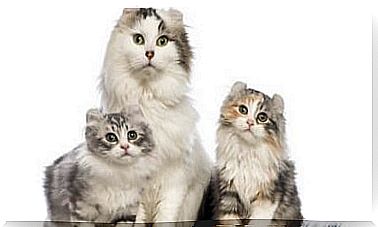Cat Welfare: What Factors Affect It?

Pet welfare is often taken for granted, because unless they have serious medical conditions, small emotional imbalances are difficult to identify. We also often have complicated lives, largely outside the home. For this reason, the question of which things can promote or diminish the well-being of the cat is seldom questioned .
However, even cats, who seem so independent at times, can suffer emotionally and physically, and taking care of them is the duty of their owners.
A symbiosis that has lasted for thousands of years
It is not yet known with absolute certainty when the interaction between cats and humans began. It is generally assumed that this symbiotic relationship began in ancient Egypt. But recent fossil evidence indicates it could be 7,000 years old. Since then, cats have been revered, loved and sadly in some historical periods, despised.
Today the role of the cat is that of a pet. In 1991 it was estimated that there were about 35 million cats in the homes of the European Union. Due to their social and individual importance, these animals have become an integral part of the family they live in and as such require attention, understanding and empathy.
In this article we will show you several factors that affect the well-being of domestic cats to some extent. For this, we will rely on a study published in the prestigious ScienceDirect portal .

A very interesting study on the well-being of the cat
This study aimed to analyze several factors to quantify feline welfare . The methodology was as follows:
- A sample group of 62 tutors and their cats was chosen. Everyone participated without knowing the true purpose of the study.
- The relationship between the cat and its tutor was quantified on several parameters: questionnaires, a physical examination of the animal and a test to quantify the level of attachment to their pet, the Lexington Attachment to Pet Scale (LAPS).
- A total score was calculated for each interaction, depending on the cat’s well-being: low (L) medium (M) or high (H).
- These parameters allowed the researchers to get a clear idea of the social, behavioral and physiological status of each animal.
The average participant profile was slightly skewed, as most of the participants were female addicts with previous experience in the cat care industry. Despite this, the results are still extremely interesting.
On what factors does the domestic cat’s well-being depend?
This study has made several things clearer.
- The results are not bad, because in terms of the quality of life of the animal, more than 70% of the cats got an average score and 17% a high score.
- Overall physical condition was very good, with 75% of cats scoring high.
- Factors such as gender, age, number of family members or the tutor’s social activities seemed to affect these percentages.
All these data are curious and positive, but it should be noted that only 16% of domestic cats did not show any abnormal behavior for their species.
This means that even though cat owners paid close attention to the animal, they were unable to fully cover their needs. So, what promotes the well-being of the cat?
- For example, cats living in multi- person households have been shown to receive more veterinary attention. This underlines the importance that all members of the family should feel a certain sense of responsibility towards the animal and take good care of it.
- Having previously had another pet reduced the cat’s problematic behavior, such as scratching and damaging objects in the house. This may be due to the fact that the most experienced tutors know what stimuli to give to the animal. It never hurts to remember, scratching posts and toys are essential for mental activation in the cat.
- Signs such as relieving themselves outside the litter box can be symptoms of stress in the animal. The results are surprising, as these behaviors have been dramatically reduced in cats from childless families. Again, there is a need to educate the little ones of the family to have the utmost respect for the pets they live with.

The responsibility of the owner
All of these findings do not mean that having children in the home, not having gained previous experience with other pets, or being a single person in the house, will make the pet suffer more.
What this type of study demonstrates is the need to understand what are the main weaknesses and shortcomings of the environment where the animal lives, to pay particular attention to them and try to solve them.
For example, if there are children in the house, they should be educated and helped to understand that the pet must be respected: not touching it excessively and without generating continuous annoying noises in its vicinity.








